Oaxaca & Puebla – Overview
Last modified:
This whirlwind overview contains highlights of each day.
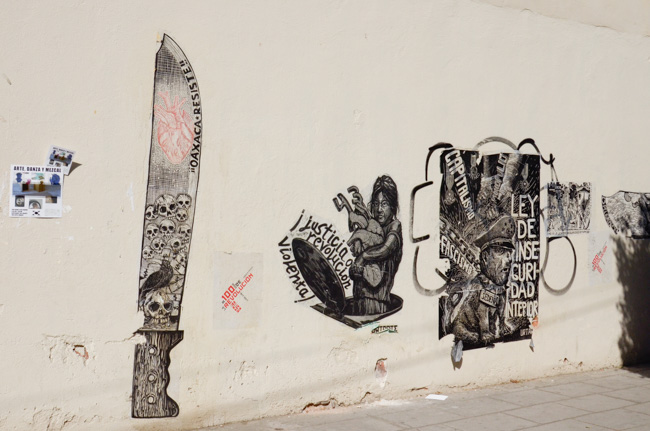
Graphic protest posters adorned most otherwise blank walls.
In December, 2017, the Mexican legislature passed a law to legalize using the military as an adjunct to the often corrupt police force in the war against drugs. This legitimizes a practice that has been in place for at least a decade. Supporters felt it was necessary; detractors felt that it opened the door for martial law.
Protests decrying violence against women may have inspired the woman holding the heart.
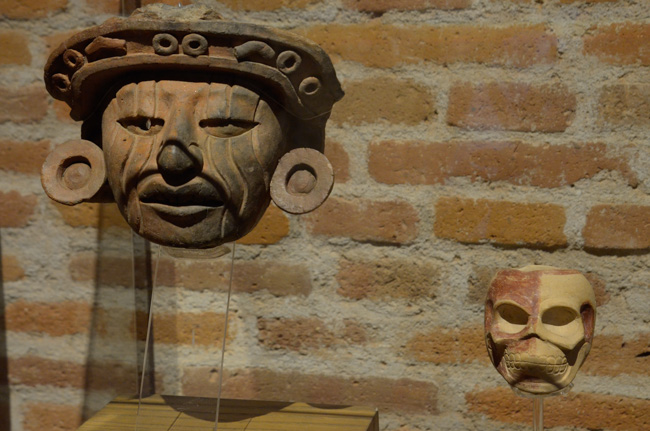
The Oaxacan Cultural Museum is housed in the former monastery of Santo Domingo. The many treasures on display included these pre-conquest masks. Mesoamerica is one of the three independent cradles of civilization where humankind made the leap from hunter-gatherer nomads to urban societies where agriculture, art and literacy developed. Oaxaca is one of the oldest centers of Mesoamerica.
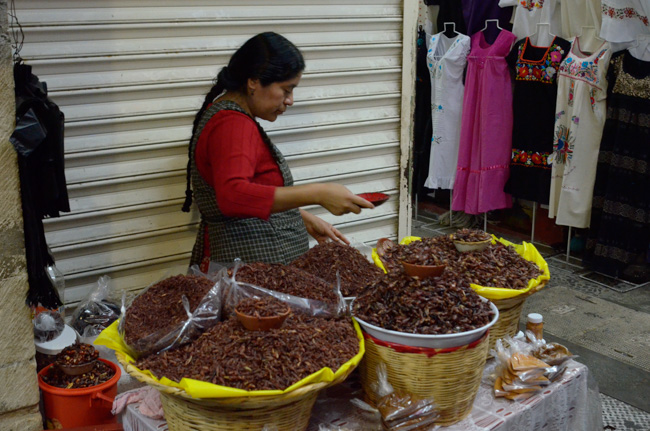
As the ancient society developed, an extensive market system evolved to trade local products throughout the region. Our morning lecture provided the background and the afternoon tour included visits to two of the local markets. The Benito Juarez Market featured everything you could desire: food, clothes, tourist traps.
Chapulines, cooked and spiced grasshoppers, were a significant source of protein prior to the Spanish importations of domestic animals and are still savored today. Haydee, our tour director, bought some of the smallest crunchies for us to sample (she herself doesn't care to look them in the eye). The saying is that if you eat chapulines you are sure to return to Oaxaca. I had some; Jim did not. The flavor was mostly due to the spices, but there was a sour aftertaste that I didn't savor.
We may return to Oaxaca some day, but we won't see eye-to-eye with chapulines!
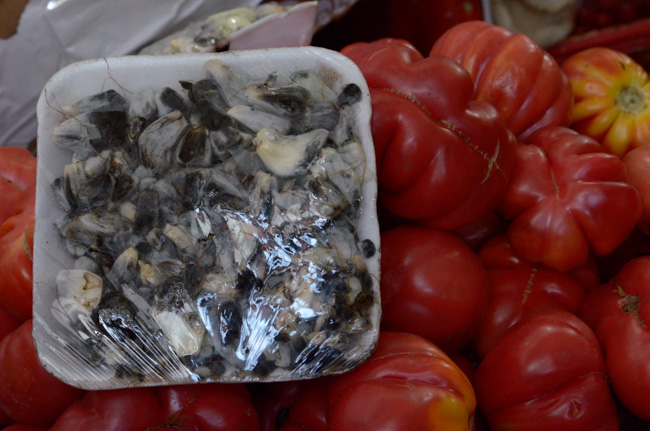
Chef Gerardo Aldeco Pinelo led our first cooking class.
Since our entire group was so large (24 people), we broke into two sections for this class. "Group B" had our session in the afternoon.
Chef Gerardo first led us through the La Merced market to select the freshest items for our endeavors. We Norte Americanos recognized many items, but some, like this display of corn smut, were unfamiliar. (Yes, it was delicious when prepared in our soup!)
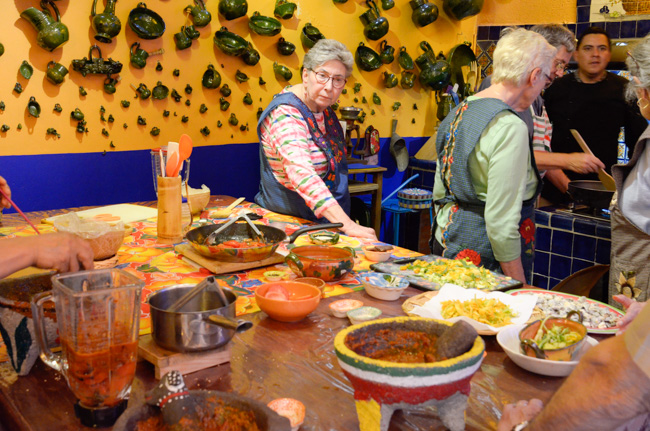
Chef Gerado's home kitchen became our classroom. We divided into small teams to perform various tasks: chopping, grinding, kneading, etc.
A "highlight" was a major (7.2) earthquake that drove us all, including the family's pet birds, into the patio for safety. After the rocking and rolling stopped we continued our class after a welcome shot of mezcal! We teased "Group A" by saying that their dishes may have been good, but ours were SO excellent that they made the earth move.
As we were eating supper and enjoying the fruits of our labor, there was a lesser (5.8) aftershock, but no need to flee the table. Another aftershock in the middle of the night woke us up. Jim and I, well-trained by six years in California, went back to sleep rather than run into the halls as many did.
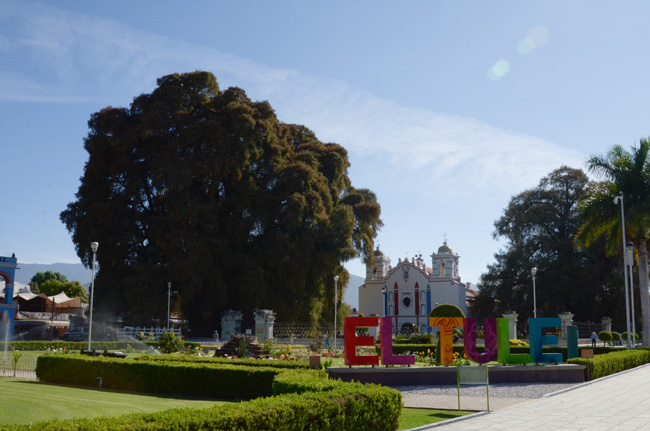
We explored the countryside west of the city on our first archeological field trip. First we visited "the" Tule Tree. The Guinness Book of World Records acknowledges it as as the "stoutest" tree in the world, but its existence is threatened by the gradual drying of the once marshy surroundings
A local nine-year-old youngster served as our authorized guide to the tree. Throughout the rest of our trip we sang out his catch phrase of "Come on, please" whenever we needed to get a move on.
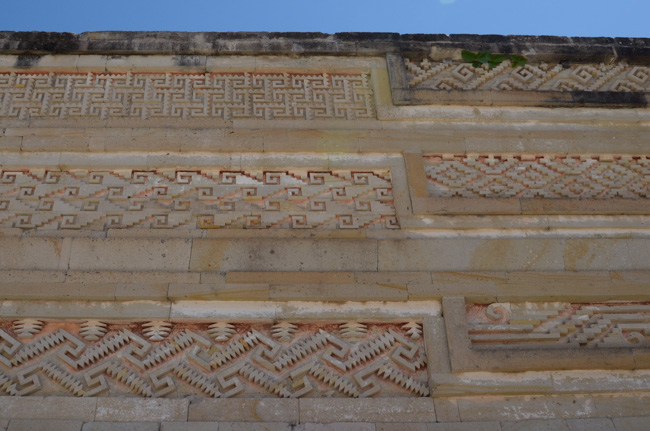
Jim and I agree that the archeological center of Mitla took first place on our list of ancient sites. Invading Spaniards desecrated this major ceremonial center and destroyed many of the buildings. Several geometric friezes made from cut and polished stones fitted together without mortar survived. Only fragments remain of the extensive frescoes.
Traces of white and red paint that once highlighted the intricate designs remain.
Casa Vasquez, a textile producer in Teotitlan del Valle, was our net stop. We bought a large wall hanging, which now graces our living room. Then at a nearby mezcal factory tasting room we learned the details of which grades of fire water contain The Worm.
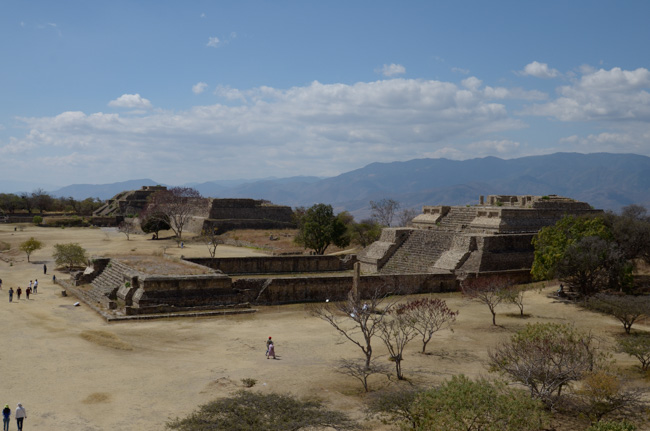
Ancient Zapotecs dug the site of Monte Alban out of a mountain top looming over Oaxaca. The Zapotecs and later the Mixtecs made use of the site for centuries, but abandoned it around 800AD. Largely forgotten by the time of the conquest, it escaped deliberate destruction by the Spaniards. Time did its work, however, and most of the buildings are reconstructions, with restored areas clearly identified.
Experts believe that the entire ceremonial complex had a hierarchical use. The main plaza was used by the common folk and the raised platform area adjoining the pyramid was used by the nobility. The ruler and high priests were the only ones who could aspire to the yet higher structure where I'm standing to take the picture.
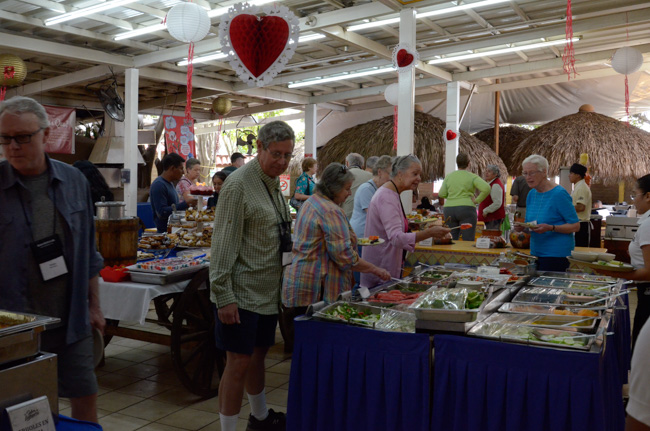
Since we're on a cooking and eating tour, it seems right to feature El Sabor de Antequera, which translates to "the taste of Antequera." The original Spanish name of Oaxaca was "Neuva Antequera," after a city in Spain.
This buffet, which had something for every taste, was dedicated to local traditional foods. It was impossible to sample more than a tiny amount of what was available.
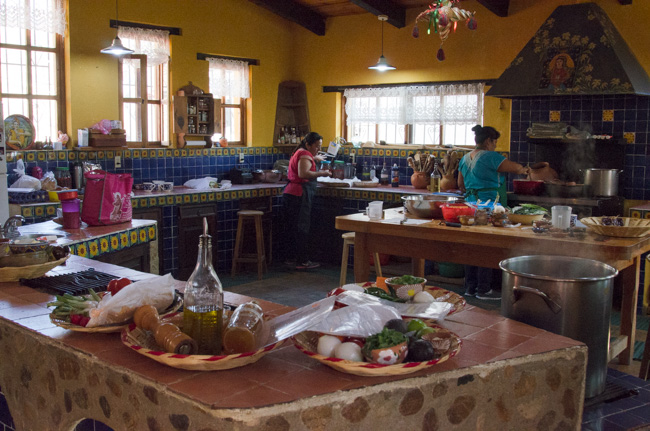
Susana Trilling, an American chef with Mexican grandparents, fell in love with Oaxaca culture and cuisine. She created Seasons of my Heart, a cooking school and PBS TV series of the same name.
The kitchen was large enough for the entire group to participate at once. Eager cooks volunteered for the various courses, and local women guided us through our tasks. Our only common language was food and cooking, but we made it work.
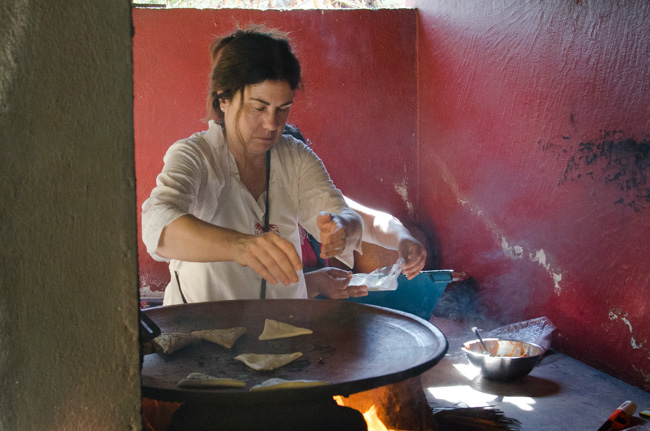
My team made a Mexican appetizer called tetelas. I hadn't realized that we would have to make everything from scratch: the bean paste, the chile sauce, and the tortillas. Other teams worked for a while on their tasks and then socialized; our team roasted, toasted, peeled, chopped, stirred, and kneaded without cease. It was great!
Communication with our local helpers occasioned some giggles as we tried to explain the difference between roasting and toasting. We found that even the English-as-a-first-language speakers couldn't agree.
After stuffing and forming the tetelas into triangles we toasted (or roasted) them on a wood-fired comal.
Jim signed up for the tortilla soup. We enjoyed many variations of this Oaxacan staple, but this was my favorite.
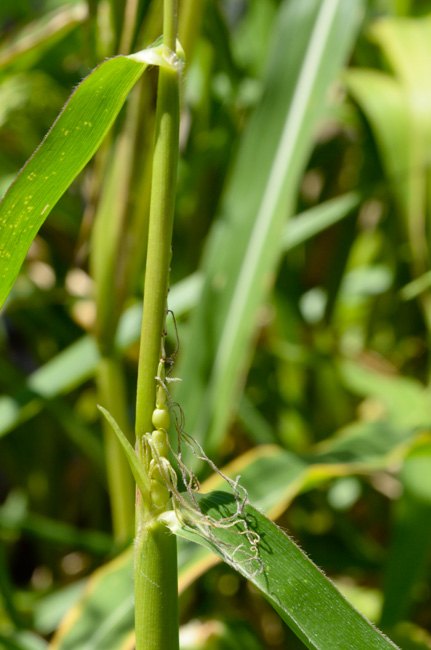
Ever since our arrival in Oaxaca we had planned to visit the Ethnobotanical Garden, but our schedules didn't align with the English-language tours until our last day. Researchers have identified the oldest domesticated ancestors of many common food plants in Oaxaca, and this garden features some of them as well as other plants significant to the native peoples for eating, drinking, wearing or trading.
DNA testing has shown that the teosinte plant is the ancestor to maize or corn. The seed husks have "silk" like modern corn, but there is no cob so the seeds can scatter and take root. Modern corn cannot reproduce itself without human intervention. The cob and husk confine the kernels and prevent them from falling to earth to geminate.
Other food plants domesticated in Mesoamerica include squash, tomatoes, chiles, chocolate and vanilla. Can you imagine Italian cooking without tomatoes? Thai cooking without chiles? Ice cream without chocolate or vanilla?
Corn, however, was the keystone of nutrition in the area (along with chapulines). The native farmers not only cultivated and improved teosinte over generations, they learned how to release its full nutritional value. The niixtamalization process is necessary to prevent pellegra in a corn-based diet.
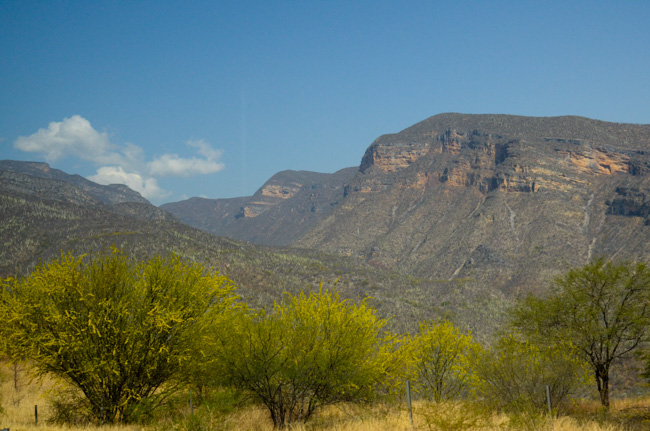
We were sorry to bid farewell to Oaxaca early the next morning but excited about pursuing new adventures in Puebla. In Oaxaca we learned much about environmental degradation since the arrival of the Spanish as well as modern land management and reclamation practices. Much of this was reinforced by what we saw along the way.
Our drive also took us through this craggy mountain range and biosphere reserve.
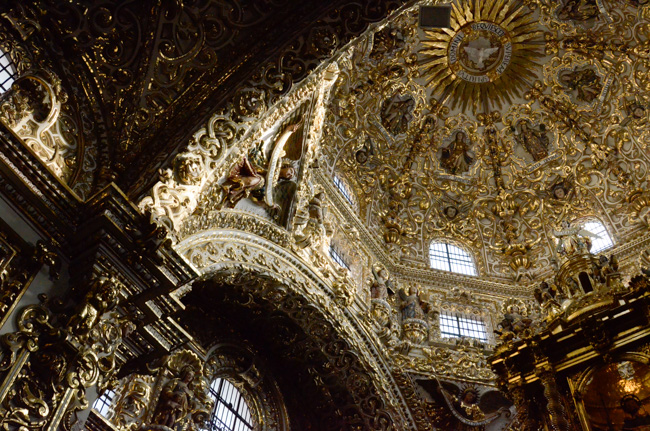
A historical walking tour provided an introduction to the Spanish city of Puebla. The Rosary Chapel, located in the Santo Domingo church, introduced us to over-the-top Mexican baroque style.
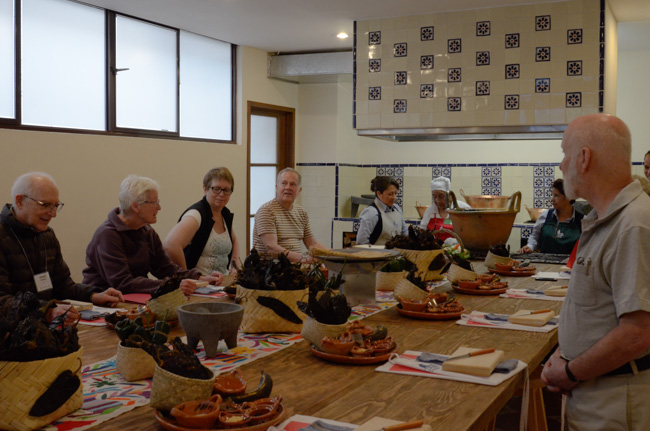
The Hotel Colonial hosted our final cooking class. Again we divided into Teams A & B. This time Team B got the morning assignment. I'm happy to say that there were no earthquakes to interrupt our concentration.
Local nuns developed mole poblano, the signature dish of Puebla, centuries ago. A large and unexpected Spanish delegation arrived on its way to Mexico City. The sisters threw everything but the kitchen sink into the preparation of enough food with limited supplies. If they had owned a kitchen sink at the time, it might have gone in too!
The staff had done the basic measuring and chopping preparation of the many ingredients for us, so we focused on new techniques of grinding and cooking.
We feasted on our mole the following evening for our last meal in Puebla. It was delicious!
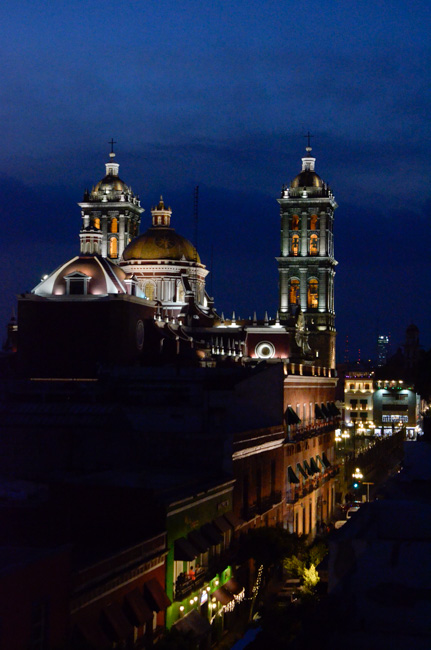
After our class and lunch at the hotel, Team B had the afternoon off. Jim and I visited local historical sights before rejoining our friends at the hotel for margaritas at sunset in the rooftop garden.
The Popocatepetl volcano had erupted in the two weeks preceding our arrival, but at present it simply provided a bit of steam to augment the sunset.
The overlook of the illuminated cathedral assumed pride of place as the sky faded.
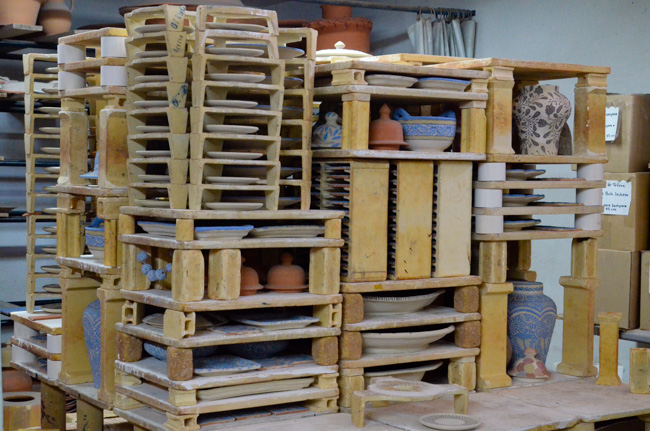
One of our fellow Road Scholars lusted after a set of the local Talavera pottery. She eagerly anticipated our next day's stop at the Talavera de la Reyna workshop where we saw it made. We observed the entire process: throwing pots, preparing glazes, and painting the intricate designs.
Stacks of pottery wait to be fired in the enormous kiln. The framework allows air circulation for even firing.
And yes, there was a gift shop.
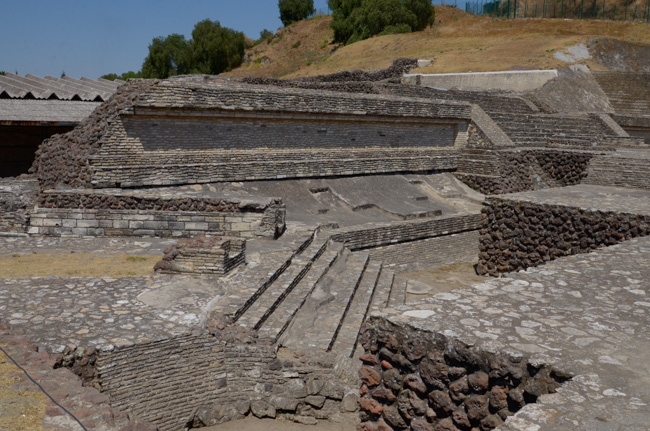
The great pyramid of Cholula is the largest by volume in the world. This is not the pyramid; it is the historical site at its base. The pyramid itself, partially seen in the background, has not been excavated and looks like nothing more than a large hill with a church on top. Archeologists developed the plan for the multi-layered pyramid by tunneling into the sides of the hill. Our guides grilled us thoroughly about potential claustrophobias before leading us through some of the very confined and twisty tunnels.
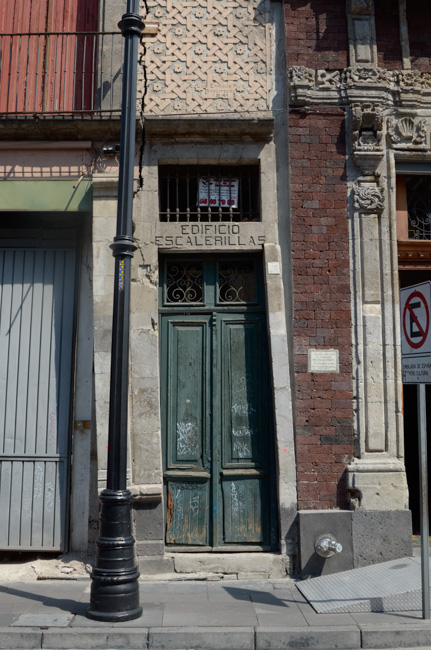
After out time in Puebla and environs we spent a few hours in Mexico City on our last day. We didn't even scratch the surface of this enormous city. (Although we were told many times that Mexico City is the second largest city in the world, I have been unable to verify that. Let's just say it's in the top ten.)
The city occupies what was once a large lake. As a result it is unstable. Structures settle at differential rates and the frequent earthquakes don't help matters. Streets waver up & down and buildings stand at odd angles.
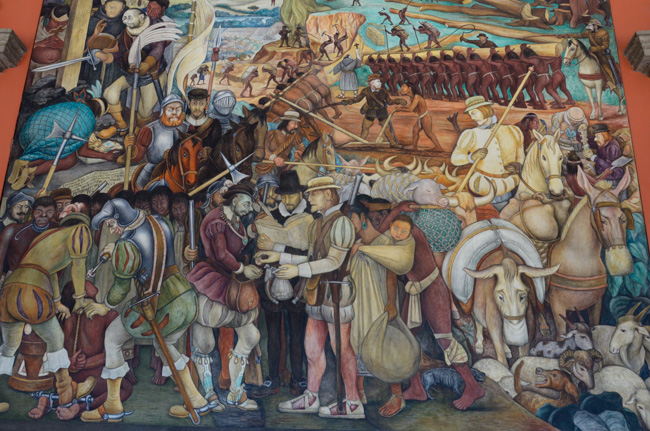
The highlight of our tour was a visit to the National Palace to see Diego Rivera's murals. He died before he could complete his overall plan, but there is still much to see.
Most of the murals had been configured such that they could be removed for safety in the event of a devastating quake.
Our guide commented that 50 years ago Frida Kahlo was known as Diego Rivera's wife. Nowadays Rivera is remembered as Frida Kahlo's husband!
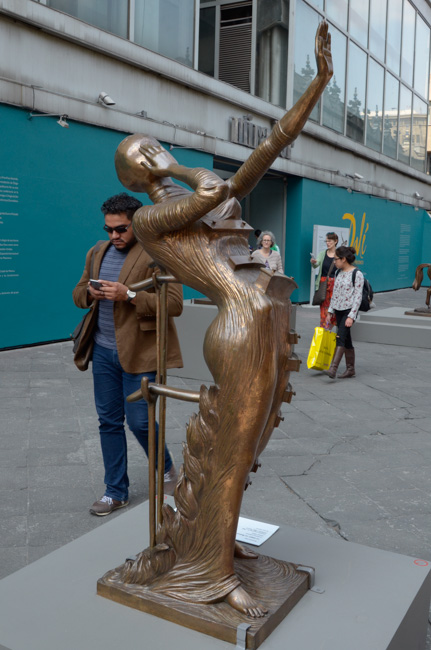
The Latino Americano Tower was part of our tour because of its high observation deck. I stayed behind because I don't like either crowds or long lines, plus I wished to see the large exhibit of Salvador Dali sculptures in the courtyard.
Our trip to Mexico was as delightful as all of our Road Scholar adventures. The guides were wonderful, the program was well-organized, and our fellow scholars were delightful. We felt we were just getting to know everyone when we had to say goodbye!
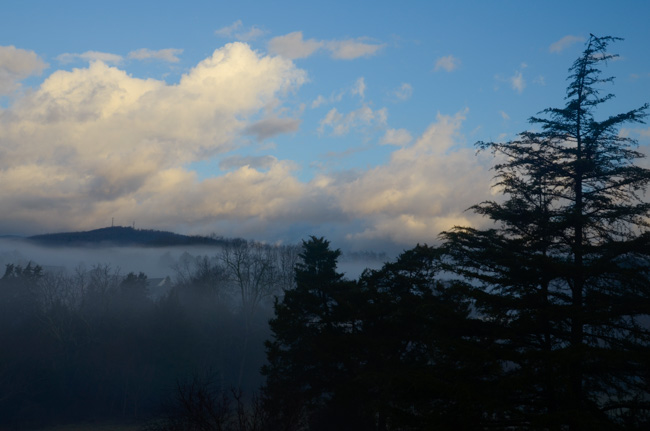
I end all of our travelogues with a picture from home. One of the main purposes of traveling for us is to appreciate what we have right here in Rockbridge County.
This was the dawn view from our back deck the week before leaving for Mexico. The fog had almost hidden our view of the Brushy Hills.
Click your "back" button to return to the previous page or click for our picture album.